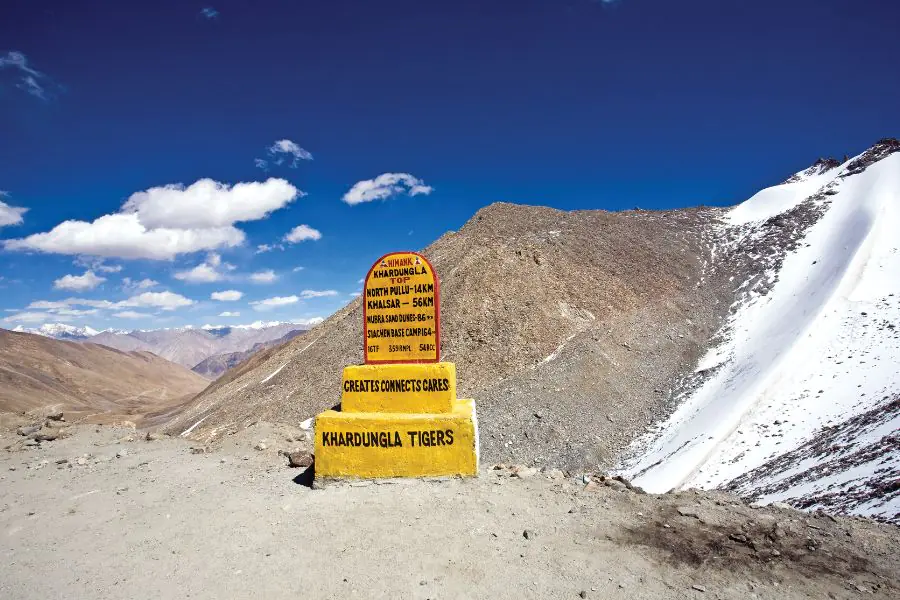10 Most Dangerous Roads in India – Nathu La Pass, Zoji La Pass

List Of Most Dangerous Roads in India: India’s geographical diversity brings with it roads that range from smooth highways to rocky, perilous paths. While these dangerous roads may offer some of the most scenic drives, they also demand extreme caution and expert driving skills. Often characterized by steep cliffs, sharp hairpin bends, unpredictable weather, and minimal infrastructure, these roads are a test of bravery and endurance.
1. Khardung La Pass, Ladakh

Khardung La is one of the highest motorable passes in the world, situated at a staggering height of 17,582 feet. Located in Ladakh, this road is notorious for its unpredictable weather and narrow paths with steep drops. The thin air at high altitude and the rough, often snow-covered, terrain make driving here extremely risky. Yet, it remains a bucket-list destination for adventure seekers.
2. Zoji La Pass, Jammu & Kashmir

Zoji La Pass, connecting Ladakh with the Kashmir Valley, is a vital yet treacherous road. The pass is prone to landslides and avalanches, especially during the winter months, making it one of the most challenging roads to drive on in India. The narrow, winding road clings to the edge of mountains, often with nothing but a deep gorge on one side.
3. Leh-Manali Highway

The Leh-Manali Highway is both famous and infamous. Stretching over 480 kilometers, this high-altitude road offers spectacular views but also presents numerous hazards, including unpaved sections, sharp curves, and altitude sickness. The road often experiences landslides and snowstorms, making it a risky yet rewarding drive for adventure enthusiasts.
4. Kinnaur Road, Himachal Pradesh

Kinnaur Road is often cited as one of the most dangerous roads in India due to its narrow paths carved into vertical cliffs. Known for its “suicide point,” this road offers almost no room for error as one side of the road is a sheer drop into the Baspa River below. Rockfalls and landslides are frequent, making the road hazardous during the monsoon season.
5. Nathu La Pass, Sikkim

Nathu La Pass, located at 14,140 feet, is one of the three open trading border posts between India and China. This high-altitude pass is often blanketed in snow, and its steep slopes can be treacherous. The thin air, biting cold, and sudden changes in weather make driving here a challenge even for the most experienced drivers.
6. Munnar Road, Kerala

Though beautiful, the Munnar Road in Kerala is a dangerous one due to its numerous hairpin bends and steep ascents. The road winds through tea plantations and mist-covered hills, but heavy rainfall often makes the road slippery, leading to frequent accidents. Drivers need to be extremely cautious, especially during the monsoon season.
7. Bum La Pass, Arunachal Pradesh

Located near the Indo-China border in Arunachal Pradesh, Bum La Pass is a high-altitude road known for its rough terrain and unpredictable weather. The road is often covered in snow, and landslides are common, making it dangerous for drivers. The lack of oxygen at this height also poses challenges for those not acclimatized to high altitudes.
8. Mumbai-Goa Highway

While the Mumbai-Goa Highway may not have the altitude challenges of the Himalayan roads, it is still one of the most dangerous roads in India. Heavy traffic, sharp turns, and narrow stretches make it prone to accidents. The scenic views of the Western Ghats may be captivating, but they also require drivers to maintain a high level of focus.
9. Shillong-Cherrapunji Road, Meghalaya

This road cuts through the lush hills of Meghalaya, connecting Shillong to Cherrapunji, the wettest place on Earth. The road is prone to landslides and flash floods during the monsoon season, making it treacherous to navigate. The foggy conditions and steep drops on one side add to the danger of this otherwise scenic route.
10. Rajmachi Road, Maharashtra

The road leading to Rajmachi Fort is an offbeat adventure but a dangerous one. It’s an unpaved, rocky path that becomes extremely slippery during the monsoon. With no barriers to protect drivers from the steep drops, this road tests your patience and skill, especially if you’re traveling by car or bike.
Conclusion
India’s most dangerous roads are not just a challenge to drive; they are an adventure waiting to be experienced. While these roads offer some of the most awe-inspiring views, they require respect, caution, and preparedness. Whether you’re navigating the high-altitude passes of the Himalayas or winding through the dense forests of the Western Ghats, remember that safety comes first.
FAQs
1. Are these dangerous roads safe for tourists?
While these roads are open to tourists, it’s essential to be prepared and drive cautiously. Hiring a local, experienced driver is often recommended.
2. When is the best time to drive on these roads?
Most of these roads are best driven during the dry season, typically from April to October, when the risk of landslides and snow is lower.
3. What should I pack for a road trip on these dangerous roads?
It’s essential to carry basic survival gear, including warm clothing, food, water, and a first aid kit, especially when traveling on high-altitude or remote roads.
4. Are there alternatives to driving these dangerous roads?
In some cases, there are safer routes or public transportation options like buses and trains, but for many, these roads are the only access routes to certain destinations.
5. What kind of vehicles are recommended for these roads?
4×4 vehicles with good ground clearance are recommended for most of these roads, especially the ones in mountainous and rough terrains.


